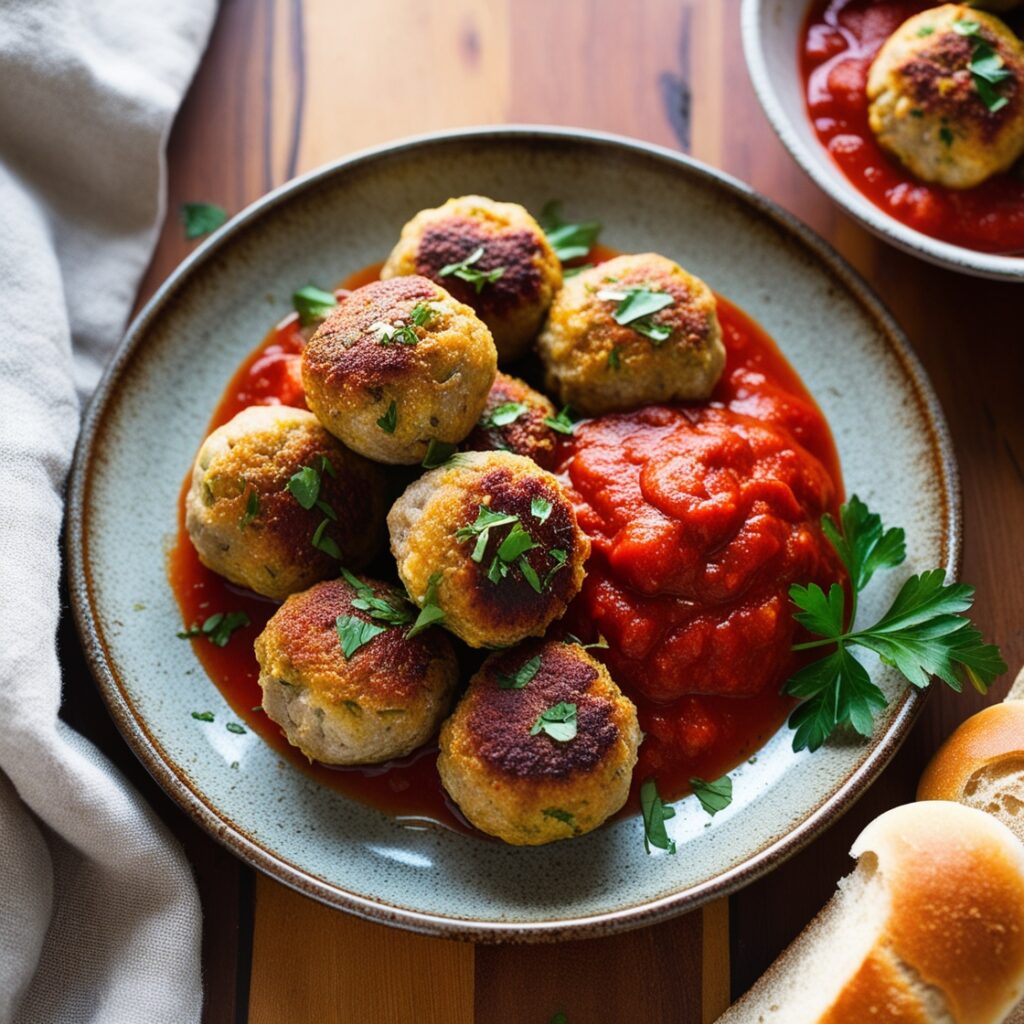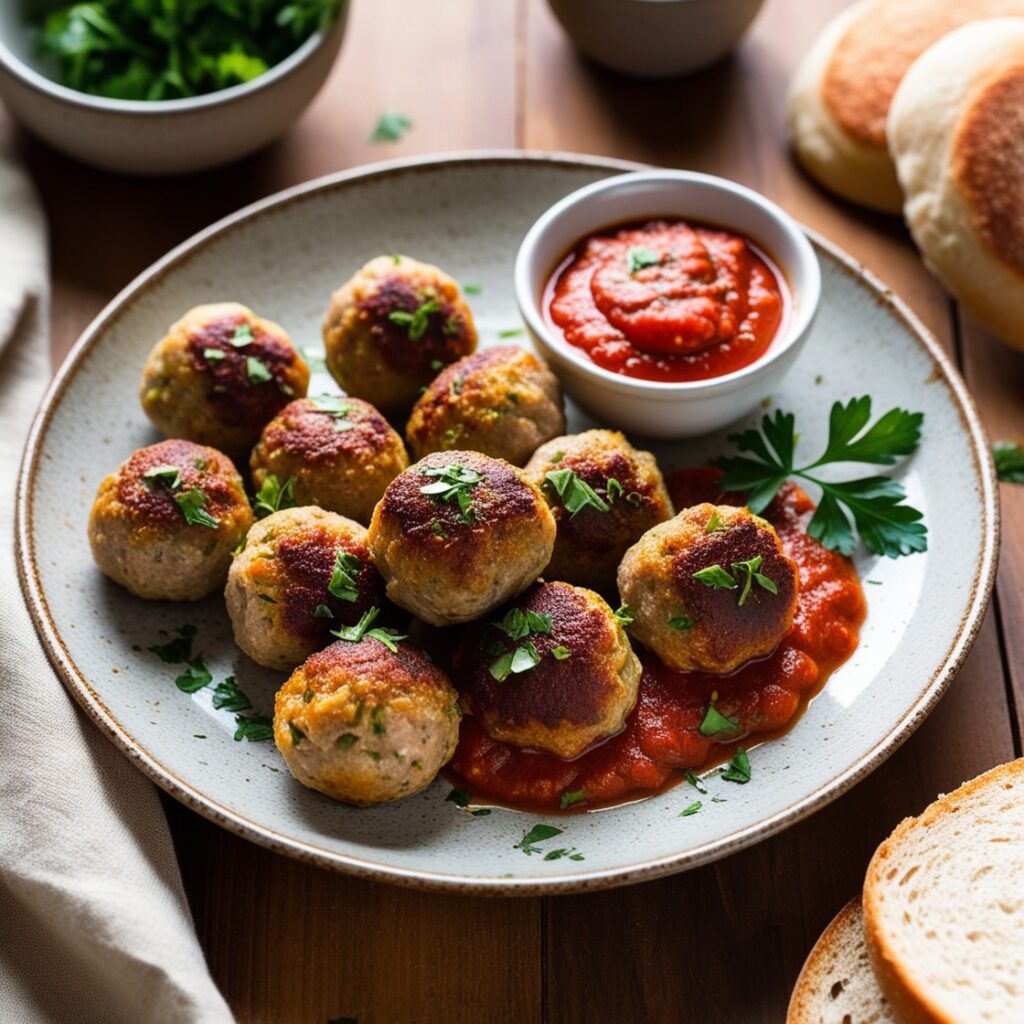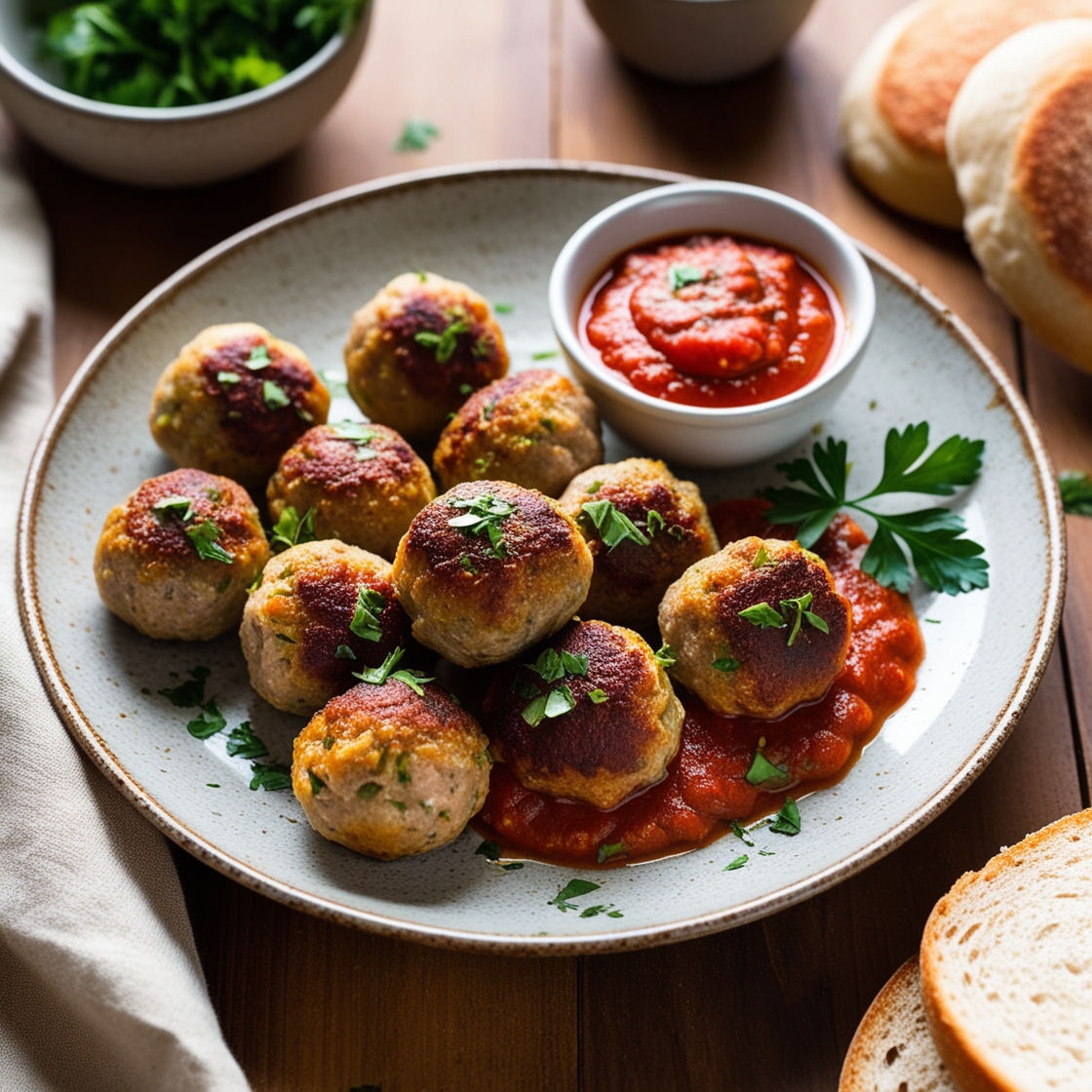- Introduction
- Discover the perfect gluten free meatballs ingredients
- Master the art of meatball preparation
- Enhance flavor with unique seasoning choices
- Perfectly cook meatballs for optimal texture
- Pair meatballs with gluten-free sauces
- FAQ
- What are some common gluten-free substitutes for breadcrumbs when making meatballs?
- How can you enhance the flavor of gluten free meatballs without using traditional seasonings that may contain gluten?
- What cooking methods can be used to prepare gluten free meatballs, and how do they affect the texture and taste?
- Can you provide a simple recipe for gluten free meatballs that includes a variety of protein options (e.g., beef, turkey, or plant-based)?
- What are some creative serving suggestions or sauces that pair well with gluten-free meatballs to elevate the dish?
Introduction
Embarking on a gluten-free lifestyle should not mean sacrificing taste or culinary enjoyment, especially when it comes to classic comfort foods like meatballs. In this article, “Easy & Delicious Gluten Free Meatballs,” you will discover how to transform a beloved recipe into a delightful and satisfying experience that aligns with your dietary needs. Whether you have celiac disease, a gluten intolerance, or are simply exploring gluten-free options, crafting meatballs without gluten is both accessible and rewarding.
By focusing on high-quality ingredients and simple techniques, you can achieve meatballs that are just as flavorful and succulent as their traditional counterparts. You’ll learn how to select the right gluten-free substitutes for binders and seasonings, ensuring each bite is packed with taste and texture.
This guide will walk you through the preparation process, offering tips on achieving perfect consistency and cooking methods that enhance flavor. With these insights, you can effortlessly prepare a dish that can be paired with a variety of gluten-free accompaniments, from pasta to salads, without compromising on taste. Get ready to elevate your culinary repertoire with these easy and delicious gluten free meatballs that promise to delight your palate and impress your guests.
Discover the perfect gluten free meatballs ingredients

In the pursuit of crafting exquisite gluten-free dishes, your selection of ingredients plays a pivotal role. It’s essential to choose alternatives that not only align with dietary restrictions but also elevate the flavor and texture of your culinary creations. Delve into the world of gluten-free grains such as quinoa and rice, which serve as excellent bases for a variety of dishes. These grains not only provide a hearty texture but also contribute essential nutrients, ensuring that your meals are both satisfying and nourishing. Additionally, consider incorporating almond or coconut flour into your recipes. These flours add a delightful nutty flavor and help create the perfect consistency in baked goods and savory treats alike.
Embrace the diverse range of gluten-free options available while paying attention to quality and flavor. Fresh vegetables and legumes, for instance, are naturally gluten-free and can add vibrant colors and textures to your meals. When it comes to binding ingredients or enhancing flavor, explore the versatility of eggs, dairy products, or plant-based alternatives, all of which can seamlessly integrate into your gluten-free repertoire. By focusing on high-quality, whole ingredients, you ensure that your dishes not only accommodate dietary needs but also resonate with robust flavors and enticing aromas, ultimately leading to a more enjoyable and healthy dining experience.
Master the art of meatball preparation
Achieving the perfect gluten free meatball requires a delicate balance of flavor, texture, and adherence to dietary needs. Begin by selecting high-quality meats, such as a blend of beef and pork, to provide a rich and satisfying base. Pay attention to the fat content, as this greatly influences the juiciness and tenderness of the final product. Incorporate finely chopped fresh herbs like parsley and oregano to enhance the aroma and flavor, while garlic and onion offer depth and a touch of sweetness.
To bind your meatballs without gluten, explore a variety of alternatives that maintain structure and moisture. Eggs serve as an excellent binding agent, ensuring the mixture holds together during cooking. Complement this with gluten-free breadcrumbs or crushed gluten-free crackers, which add a subtle crunch and additional flavor. As you form each meatball, handle the mixture gently to avoid compacting, which can lead to dense results. Whether baked, fried, or simmered in sauce, your attention to detail throughout the preparation process will result in meatballs that are truly a delight to every palate.
Enhance flavor with unique seasoning choices
you have the opportunity to elevate the taste profile by experimenting with an array of unique seasonings. Consider incorporating smoked paprika for a hint of smokiness or chipotle powder to introduce a mild heat that complements the savory ingredients. A dash of nutmeg or allspice can add unexpected warmth and complexity, transforming your meatballs into a memorable culinary experience.
Additionally, consider using citrus zest or a splash of balsamic vinegar for a touch of acidity that brightens the flavors and balances the richness of the meat. Incorporating international spices such as za’atar or sumac can infuse your dish with exotic notes, captivating the palate with their bold and aromatic qualities. By thoughtfully selecting and combining these seasonings, you can craft gluten free meatballs that are not only delicious but also distinctively flavorful, ensuring every bite is an adventure.
Perfectly cook meatballs for optimal texture
Achieving the ideal texture in meatballs requires careful attention to both cooking techniques and ingredient proportions. Begin by ensuring that your meat mixture is well-balanced; too much binder, such as eggs or breadcrumbs (or gluten-free alternatives), can result in a dense texture, while too little can cause them to fall apart. Strive for a consistency that holds together without being overly compact. When shaping the meatballs, avoid packing them too tightly, as this can lead to toughness. Instead, gently roll them between your palms to form uniform balls that cook evenly.
When it comes to cooking, consider methods that best retain moisture while achieving a pleasing exterior. Browning the meatballs in a hot skillet before simmering them in sauce can enhance flavor and provide a desirable, slightly crispy crust. Ensure the skillet is not overcrowded to allow even browning. Alternatively, baking the meatballs on a wire rack set over a baking sheet can facilitate even heat distribution and excess fat drainage, yielding a tender interior with a golden outer layer. Regardless of the cooking method, monitor the internal temperature, aiming for around 160°F (71°C), to ensure they are perfectly cooked without becoming dry.
Pair meatballs with gluten-free sauces

When crafting a delightful meal, pairing meatballs with gluten-free sauces can elevate your dish while accommodating dietary preferences. Focus on selecting sauces that not only align with gluten-free requirements but also complement the flavor profile of your meatballs. For instance, a rich tomato-based sauce enhanced with fresh herbs and a touch of garlic can bring out the savory notes of traditional beef or pork meatballs. If you’re seeking a lighter option, consider a lemon-butter sauce with fresh parsley, which pairs excellently with poultry or fish-based meatballs.
Additionally, venture into diverse culinary territories by experimenting with international flavors. A coconut curry sauce with hints of lime and ginger can add an exotic twist to your meal, perfectly matching chicken or turkey meatballs. Meanwhile, a teriyaki glaze with a subtle sweetness and a hint of umami can harmonize with beef or vegetable-based alternatives. Always verify the label of store-bought sauces to ensure they are certified gluten-free, or take the opportunity to create homemade sauces, allowing for greater control over ingredients and flavors. This not only guarantees safety for gluten-sensitive diners but also provides a personalized touch to your delectable creations.
Print
Delicious Gluten Free Meatballs
- Total Time: 35 minutes
Description
you will discover how to transform a beloved recipe into a delightful and satisfying experience that aligns with your dietary needs. Whether you have celiac disease, a gluten intolerance, or are simply exploring gluten-free options, crafting meatballs without gluten is both accessible and rewarding.
Ingredients
For the meatballs:
1 lb ground beef (or a mix of beef and pork for extra flavor)
1 egg
½ cup gluten-free breadcrumbs (or almond flour for a low-carb version)
¼ cup grated Parmesan cheese
2 cloves garlic, minced
1 teaspoon dried oregano
1 teaspoon dried basil
½ teaspoon salt
¼ teaspoon black pepper
¼ cup chopped fresh parsley (optional)
For the sauce (optional):
1 cup marinara sauce (make sure it’s gluten-free)
Instructions
Preheat the oven:
Preheat your oven to 375°F (190°C). Line a baking sheet with parchment paper for easy cleanup.Mix the meatball ingredients:
In a large bowl, combine the ground meat, egg, gluten-free breadcrumbs (or almond flour), Parmesan cheese, garlic, oregano, basil, salt, pepper, and parsley (if using). Mix everything together until just combined—don’t overwork the meat to keep the meatballs tender.Form the meatballs:
Use your hands to shape the mixture into meatballs, about 1 to 1.5 inches in diameter. Place them evenly on the prepared baking sheet.Bake the meatballs:
Bake the meatballs in the preheated oven for 15-20 minutes, or until they’re golden brown and cooked through. You can check doneness by cutting one in half—there should be no pink in the center.Serve with sauce (optional):
If you’re using marinara sauce, you can heat it in a saucepan while the meatballs bake. Once the meatballs are cooked, serve them with a spoonful of the warm marinara sauce on top, or simply enjoy them on their own!Serve and enjoy:
Serve these gluten-free meatballs with your favorite sides—perhaps some gluten-free pasta, roasted veggies, or a crisp salad!
- Prep Time: 15 minutes
- Cook Time: 20 minutes
- Category: Gluten free
- Cuisine: Italian
For more Gluten free recipes check this out:
- Delicious Gluten Free Crackers: Tasty Snack Options
- Are Corn Tortillas Gluten Free? A Comprehensive Guide
- Gluten Free Red Velvet Cake Mix: A Delicious Treat for Everyone
FAQ
When exploring gluten free meatballs recipes, consider these questions:
- What gluten-free breadcrumbs or substitutes can you use for binding?
- How can you ensure the meatballs remain moist without gluten ingredients?
- Which herbs and spices enhance the flavor of gluten free meatballs?
- What cooking methods yield the best texture for gluten free meatballs?
- How can you create a gluten-free sauce to complement your meatballs?
By addressing these questions, you can craft delicious, gluten-free meatballs that cater to your dietary needs without sacrificing taste or texture.
What are some common gluten-free substitutes for breadcrumbs when making meatballs?
When making gluten-free meatballs, you can use several substitutes for breadcrumbs. Consider using almond flour or almond meal, which offers a nutty flavor and helps bind the ingredients. Crushed gluten-free crackers or gluten-free oats are also great choices for texture and binding. Finely ground cornflakes or rice cereal can add a slight crunch. Additionally, you might try using mashed potatoes or cooked quinoa to keep the meatballs moist and tender. Each option brings a unique texture and flavor, so feel free to experiment to suit your taste and dietary needs.
How can you enhance the flavor of gluten free meatballs without using traditional seasonings that may contain gluten?
To enhance the flavor of gluten free meatballs, you can use fresh herbs like basil, parsley, or cilantro for a burst of freshness. Add minced garlic and onions for depth, and incorporate spices like cumin or smoked paprika for a smoky touch. Grated Parmesan or nutritional yeast can add umami without gluten. Consider using gluten-free soy sauce or tamari for savory notes. For moisture and flavor, mix in a splash of balsamic vinegar or lemon juice. Finally, use gluten-free breadcrumbs or crushed nuts for texture and flavor enhancement. This combination avoids gluten while delivering rich, satisfying taste.
What cooking methods can be used to prepare gluten free meatballs, and how do they affect the texture and taste?
To prepare gluten-free meatballs, you can use baking, pan-frying, or slow cooking. Baking results in evenly cooked meatballs with a firm texture and a slightly crispy exterior. Pan-frying gives them a golden crust, adding a richer flavor and a juicy interior. Slow cooking allows the meatballs to absorb flavors from sauces, making them tender and moist. Each method enhances taste and texture differently, allowing you to choose based on your preference for crispiness, juiciness, or tenderness while ensuring they remain gluten-free.
Can you provide a simple recipe for gluten free meatballs that includes a variety of protein options (e.g., beef, turkey, or plant-based)?
Certainly! Start by choosing your protein: ground beef, turkey, or a plant-based alternative. Combine 1 lb of your chosen protein with 1/2 cup gluten-free breadcrumbs, 1 beaten egg, 1/4 cup finely chopped onion, 2 cloves minced garlic, salt, pepper, and 1 tsp Italian seasoning. Mix thoroughly. Form into 1-inch balls and place on a baking sheet. Bake at 400°F (200°C) for 20-25 minutes or until cooked through. Enjoy them with your favorite gluten-free pasta or on their own with sauce.
What are some creative serving suggestions or sauces that pair well with gluten-free meatballs to elevate the dish?
To elevate gluten free meatballs, consider serving them with a zesty marinara sauce or a creamy garlic Alfredo. You might try a tangy mango salsa for a refreshing twist or a rich mushroom gravy for depth. A spicy sriracha aioli can add heat, while a sweet and sour sauce offers a delightful balance. Pairing with a chimichurri sauce introduces a vibrant, herby flavor. Serve atop zucchini noodles or cauliflower rice for a full gluten-free experience. Adding garnishes like fresh herbs or grated Parmesan can further enhance the dish, making your meal both creative and delicious.


1 thought on “Delicious Gluten Free Meatballs”